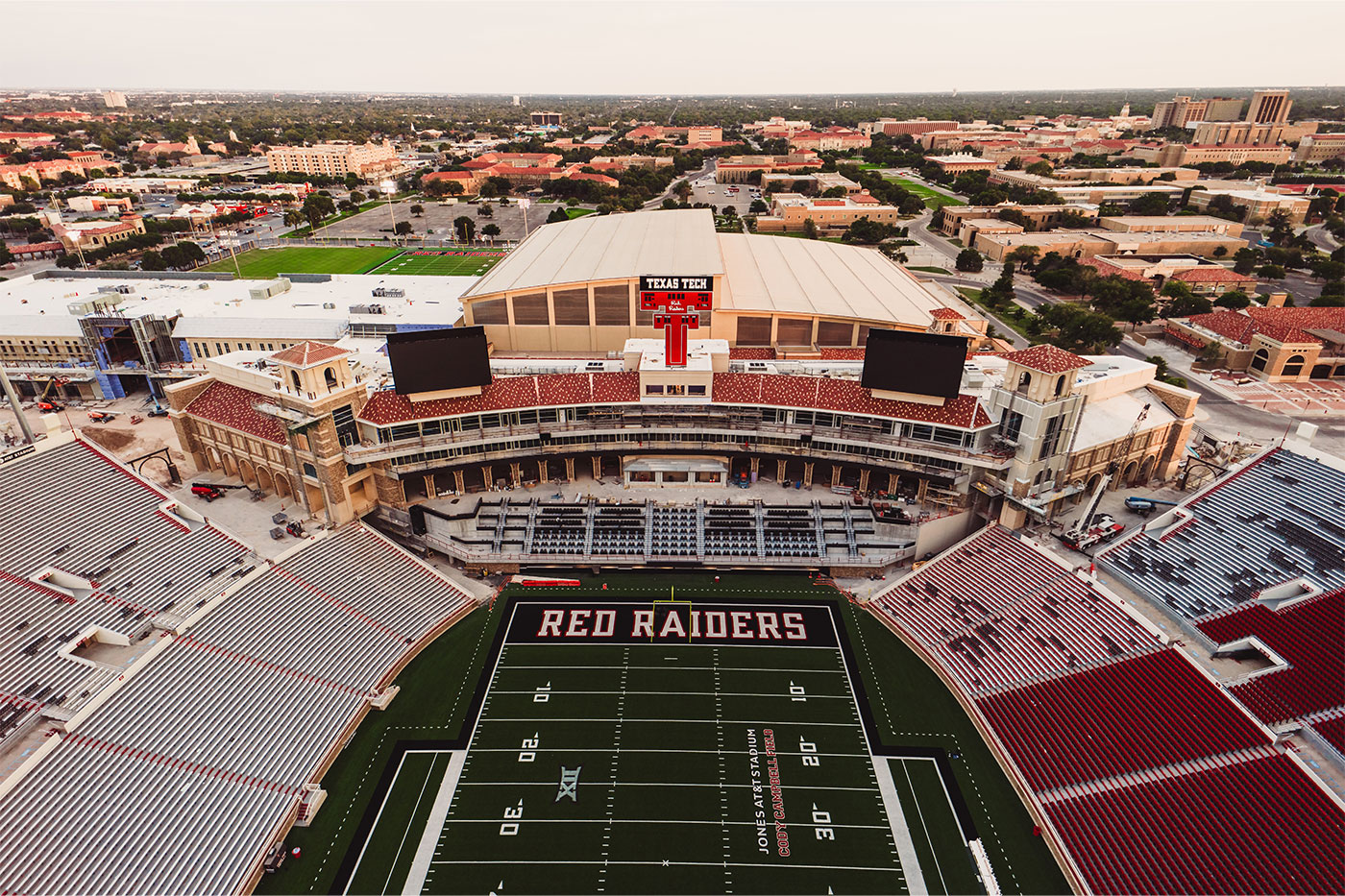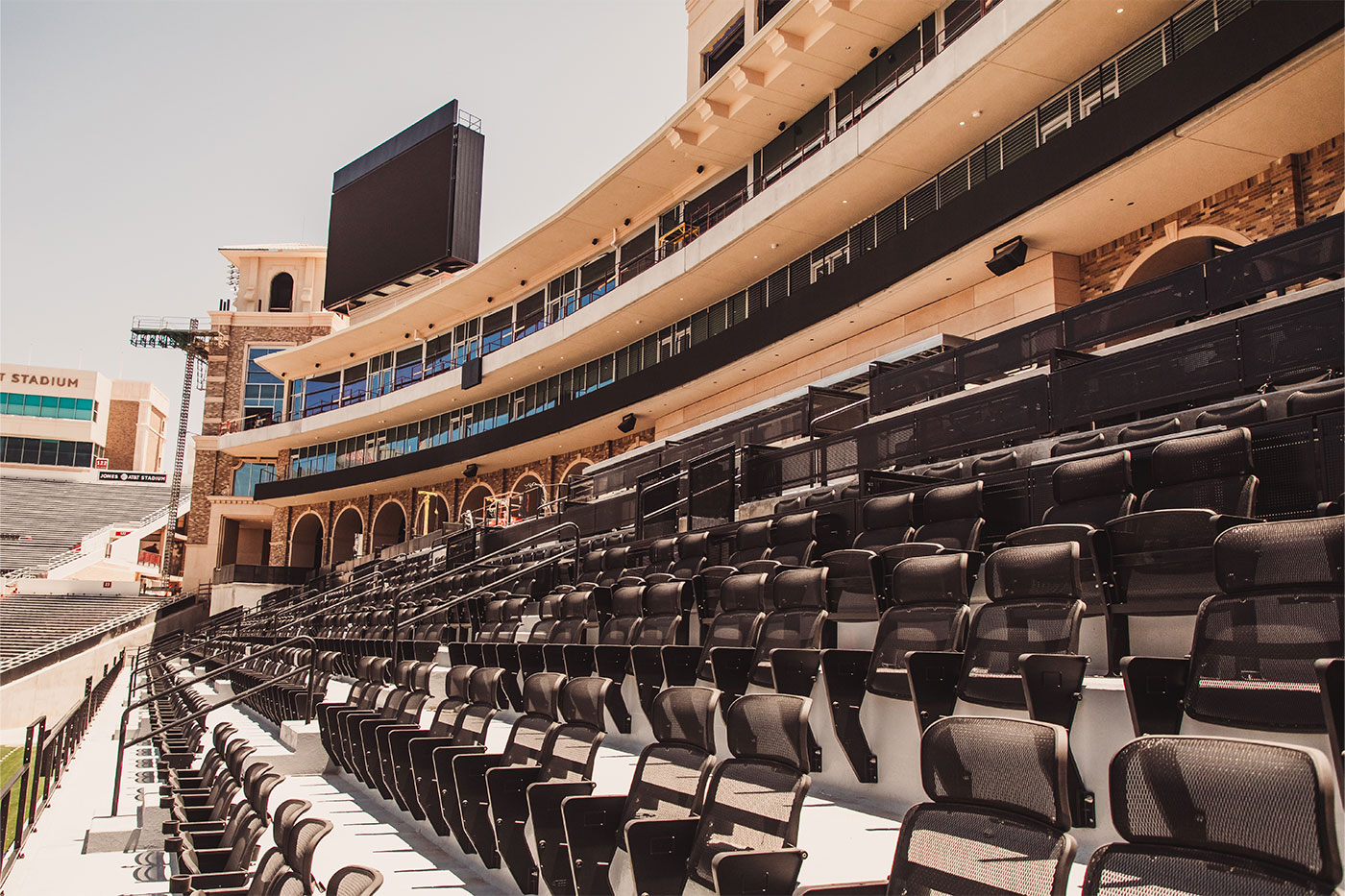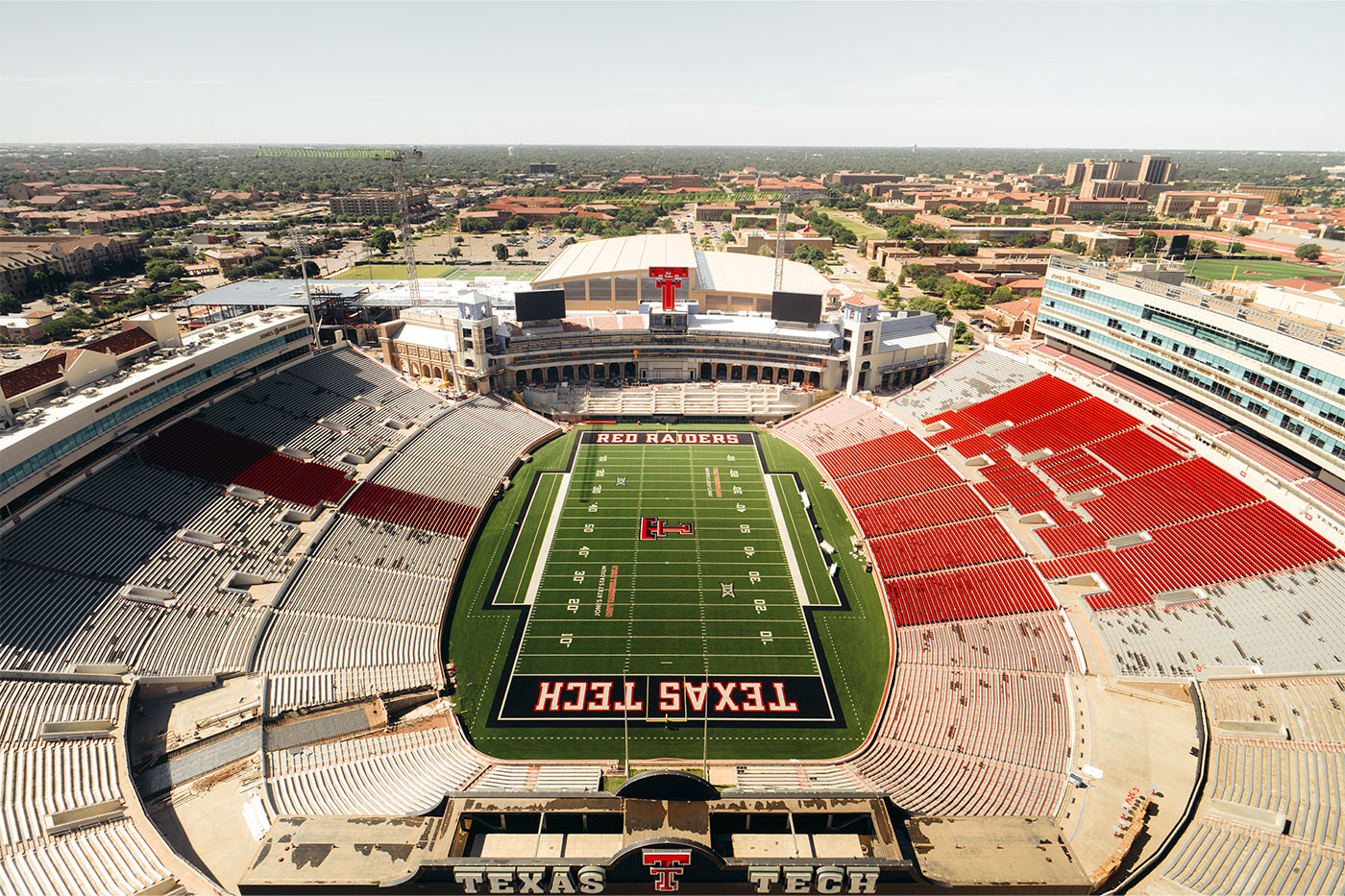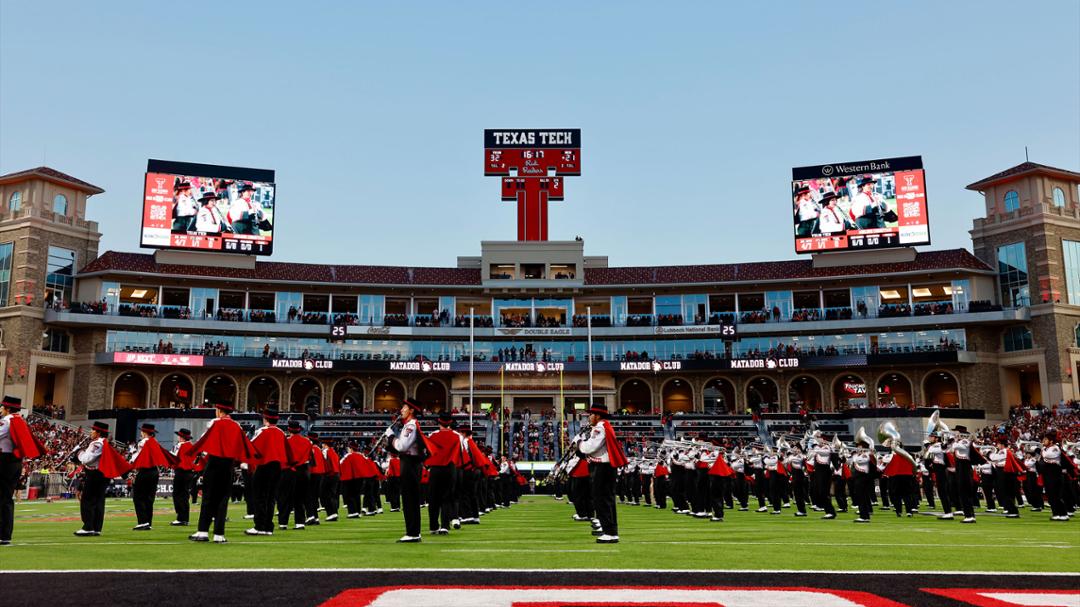The south end zone and the Womble Football Center came together through the work of Red Raiders to enhance the space while honoring tradition.
Jones AT&T Stadium has received many enhancements over the years.
The final piece of remaining renovation was the south end zone. Designs had been pitched over the years but nothing stuck. Whereas most of the stadium had been decked-out with updated seating, the south end zone remained brimming with harsh metal bleachers.
Along with the end zone, the Texas Tech Red Raiders football team also needed new training facilities. There was a need for state-of-the-art infrastructure to keep up with recruiting.
The only challenge?
This would take millions of dollars and years to build.
No one wanted to make the stadium, the heartbeat of campus, a longstanding construction zone. In many cases, when college football stadiums undergo construction, it can affect the program for years.
That’s when Texas Tech University alumnus Chris Huckabee came into the picture.
Since then, this project has become truly a product for Red Raiders, by Red Raiders, as Huckabee assembled a team of project managers, engineers, architects and more, who all have personal ties to Texas Tech.

A Homemade Passion
Huckabee, an alumnus of the Huckabee College of Architecture (renamed in honor of his father in 2022), is a lifelong Red Raider. In addition to earning his degree from the university, he has served on the Texas Tech University System’s Board of Regents and is actively involved with Huckabee College.
He met his wife Robin at Texas Tech, and many of their early memories were at football games.
“My wife is one of the most avid Texas Tech football fans you’ll ever meet,” he said.
Robin, an interior designer, had certain expectations for the new end zone and football training facility. Most important in her mind was the Double T Scoreboard remaining in the stadium.
“She made it clear if we removed that scoreboard, I would need to go find myself a new wife,” Chris laughed.
Robin wasn’t alone in her feelings, though. Fans were quite vocal about the Double T Scoreboard staying, and it has. The new design has certainly modernized the stadium, but with the team largely consisting of Texas Tech alumni, they understood the assignment in a way outsiders would not.
Huckabee assembled his team and immediately went to work, with construction starting after the 2022 football season. He was given the freedom to choose his own people, which he did with painstaking attention to detail.
For projects like this one, firms often come and present their designs at the client’s office.
Huckabee did things differently.
“We went to their firms and interviewed everyone,” he said. “It worked us a little harder, but there was a reason. We wanted to meet their entire team and vet everyone. We wanted to see other projects they’d done. We wanted to know if they aligned with our vision.”
That vision was four-pronged.
Mark Fewin was brought on to help the team move toward that end. Fewin is president of Guidon Real Estate Project Solutions, the project managers of the south end zone and the Womble Football Center. He is an alumnus of the Edward E. Whitacre Jr. College of Engineering, earning his degree in construction engineering technology in 1982. He also serves on the board of the Texas Tech Alumni Association.
“We’ve been consistent from the beginning in achieving four goals,” Fewin said. “First was to only let construction impact one season. Second was to create a monumental front door for Texas Tech Football. Third, we wanted to enhance the fan and student athlete experience. And fourth, we wanted to future-proof the project to accommodate for the dynamic and ever-changing requirements of college athletics.”

Like Huckabee, Fewin had his own personal ties to the project.
“My dad played football at Texas Tech back in the ‘50s,” he said. “I grew up a big Texas Tech fan.”
While Fewin’s family lived in Houston, they attended every away game against Baylor, Rice and Texas A&M. They’d tailgate all day and cheer all night and then drive home late Saturday because their dad taught Sunday School in the morning.
When it came time for Fewin to choose a university, his parents saved money and told him he could “attend any university he wanted as long as it was Texas Tech.”
“I’m so glad I did,” he said. “I made lifelong friendships there and I’m proud to be a Red Raider.”
Fewin, being in Dallas, wanted to bring someone local onto the project. Logan West, senior director at Guidon in Lubbock, was selected to oversee the project from inception to completion. West also happened to be a Texas Tech alumnus. He earned his Bachelor of Science in Architecture from Huckabee College as well as a Master of Business Administration from Rawls College of Business and a secondary Master of Architecture.
After Guidon was hired as the project manager, Populous was selected as architect and Lee Lewis and Manhattan as contractors.
Usually one contractor would be chosen, but Huckabee felt Lee Lewis Construction and Manhattan Construction partnering together would produce the best result. Populous, a global design firm that specializes in large venues such as stadiums and concert halls, was selected for its original designs. (Populous has designed spaces such as the Sphere in Las Vegas, GEODIS Park in Nashville and Gillette Stadium’s north end zone).
Ryan Donahue was another alumnus who joined the team. A structural engineer with Brockette, Davis and Drake, he earned his civil engineering degree from Texas Tech and was a linebacker for former head coach Spike Dykes.
“Working on this project has brought back a lot of memories,” Donahue said. “The program has come a long way, and this will take it even further.”
While Donahue helped assemble the structural plans for the new end zone, he has one plan in mind for the future.
“Obviously I want us to win games,” he said.
And he wasn’t alone in that sentiment. The end zone and facilities not only had to look great, they also needed to enhance the player experience.
“If you go down and stand on the 20-yard line, the sound is intimidating,” Huckabee beamed. “It’s going to make the Jones an even harder place for opponents to play.”

End Result
Along with being louder, the enclosed height of the new end zone makes the field feel exactly as Huckabee said – intimidating. And while serving the needs of the student athletes and fans was certainly one of the team’s goals, they feel they’ve executed the others as well.
The new end zone opened at the start of the 2024 season, meaning construction only affected the 2023 season. Huckabee said the contractors delivered the project in record time. It was originally going to take 36 months to complete, but the team pushed to move faster.
“We wanted to shorten that duration,” Huckabee said. “We’ve built something of exceptional quality and design in 21 months.”
As far as creating a monumental front door to Texas Tech football and keeping up with the changing demands of college sports, Huckabee and his team feel they’ve done that, too.
The Womble Football Center is set to open after the start of the season but is close to completion. Much like its basketball counterpart across campus, the facility will provide state-of-the-art features for the talent Texas Tech recruits.
Fewin recalls the remark President Lawrence Schovanec made when the concept was first presented to the Board of Regents.
“This project will not only help us recruit world-class athletes to Texas Tech, but it will also attract world-class students,” Schovanec said.
Fewin agrees and hopes the impact will reach beyond athletics and into every facet of campus life.
“It’s not just about football on Saturday night,” Fewin said. “Texas Tech is an institution of higher education, and our students are a vital part of that.”
When there is a need, Red Raiders come together to find a way to meet it. This project was no exception.
“We all trusted each other,” Huckabee said. “And I think the end result speaks for itself.”

